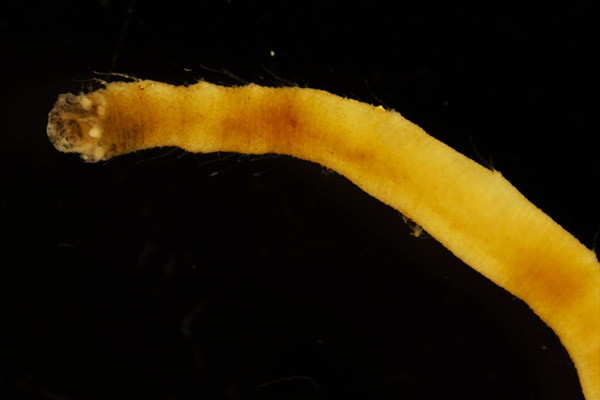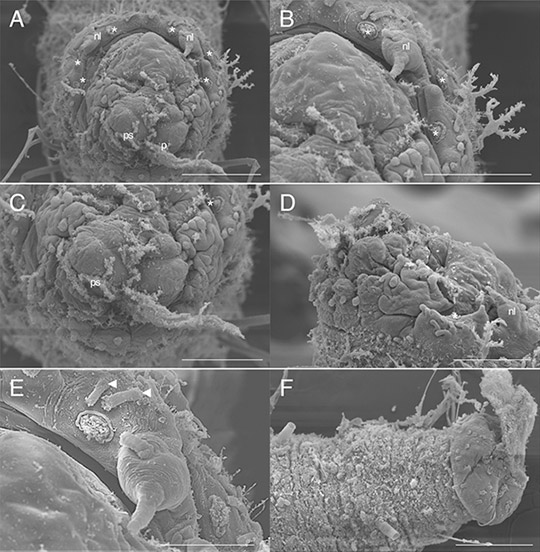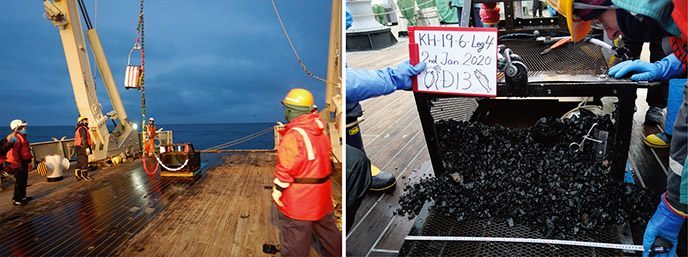National Institute of Polar Research
Biologists discover new species of sea worm in the Southern Ocean
August 17, 2020
updated December 21, 2020
National Institute of Polar Research
Earlier this year, a team from Japan’s National Institute of Polar Research (NIPR), National Museum of Nature and Science (NMNS), and Kochi University (KU) set out to collect specimens of sea worm near the South Orkney Islands, a remote region of the Southern Ocean about 400 miles northeast of the tip of the Antarctic Peninsula.
The researchers collected material from the sea floor at depths of 2,036 to 2,479 meters, a segment that falls within what oceanographers call the bathyal zone (1,000 to 4,000 meters deep). Amid the collected seafloor material, they observed a new Acrocirridae, a family that now includes 43 species of worm. The team, led by Naoto Jimi, a postdoctoral fellow at NIPR, published their findings in Biodiversity Data Journal on June 8, 2020.
The team’s process involved extracting rock and silt sediments using a sieve with seawater and fixing them in an ethanol solution. They observed a variety of captured specimens under a microscope and photographed them with a high-resolution digital SLR. The newly-identified worm , one of a species belonging to the genus Flabelligena, is named "Flabelligena hakuhoae."

The new species of worm is now one of six described species of Flabelligena, which are known mainly from the North Atlantic Ocean. Credit: Naoto Jimi, NIPR
Flabelligena falls within the broad class of worms called polychaetes, which contains over 10,000 species. “Polychaetes are one of the most diverse groups in marine benthic animals and well-studied in the Southern Ocean," Jimi said. “Many researchers have investigated the Southern Ocean, but our knowledge of small deep-sea invertebrates is still quite limited."
Jimi and his NIPR, NMNS, KU co-authors described the Flabelligena hakuhoae as having a “minute” body, body papillae (small rounded protuberance), 3 pairs of branchiae (gill-like organs), absence of eyes, and a pair of frontal palps. Its body is about 1.8 centimeters long and 1 millimeter wide and rounded on both ends.
The new species of worm is now one of six described species of Flabelligena, which are known mainly from the North Atlantic Ocean. Three species of Flabelligena are from the Southwest Atlantic, Mediterranean, and South Indian Oceans. They all live in sandy mud areas, mainly in the bathyal to abyssal depths (1,000 meters and deeper). According to Jimi, the new species are the first records of Flabelligena found in the Southern Ocean. The discovery of team will also contribute dramatically to the understanding of biodiversity of the Antarctic region.
Jimi and his team hope to discover more species and continue to learn more about the vast Southern Ocean. “This is just the first step in understanding the biodiversity of the Antarctic Ocean," Jimi said. “The next step is to understand the polychaete diversity around Syowa Station.
Syowa Station is Japan’s Antarctic research station located in East Ongul Island, Antarctica.

Scanning electron micrographs of the new species of sea worm Flabelligena. Credit: Naoto Jimi, NIPR

Left: The image showed the collection gear after sampling off the South Orkney Island in the Southern Ocean. Right: Researchers collected samples to study the species Flabelligena in the Southern Ocean. Credit: Naoto Jimi, NIPR
Paper information
Journal: Biodiversity Data Journal 8: e53312
Title:A new deep-sea species of Flabelligena from off the South Orkney Islands, the Southern Ocean
Authors:
Naoto Jimi (National Institute of Polar Research)
Akito Ogawa (Graduate School of Science, The University of Tokyo)
Shimpei F Hiruta (Center for Molecular Biodiversity Research, National Museum of Nature and Science)
Minoru Ikehara (Center for Advanced Marine Core Research, Kochi University)
Satoshi Imura (National Institute of Polar Research / Department of Polar Science, SOKENDAI)
DOI: 10.3897/BDJ.8.e53312
URL: https://bdj.pensoft.net/article/53312/
Published: June 8, 2020
Acknowledgements
This study was partly supported by JSPS KAKENHI 19J00160.
Contact
Public Relations Section, NIPR
kofositu@nipr.ac.jp








